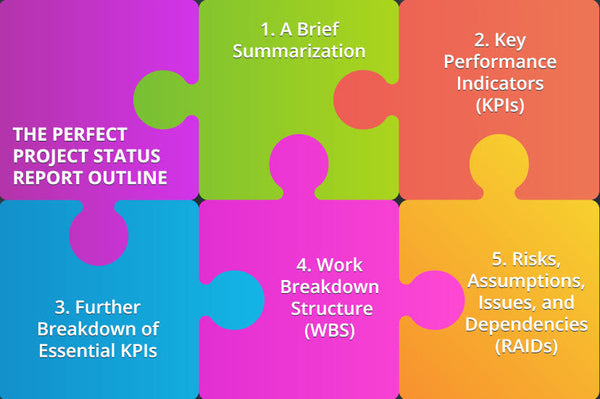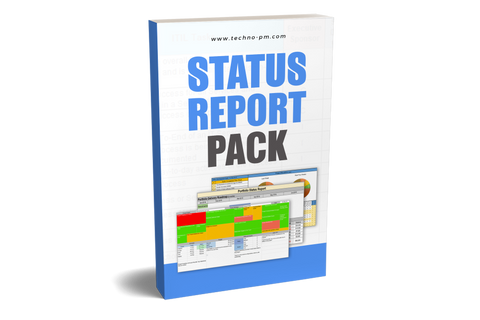How To Write Status Report?
What is a Status Report?
Would you know a high-quality project status report if you saw one? Don’t worry; most people wouldn’t. And that really is a shame because, in today’s fast-paced world of modern business, there’s no better way of delivering crucial data to stakeholders than a well-crafted project status report.
After all, the key to making good business decisions has the right information. And comprehensive project status reporting gives you just that: clear, actionable figures to inform future decisions.

How to Create an Impactful Project Status Report?
This in-depth guide will take you through how to craft a quality project status report, some of the essential KPIs involved, and we’ll also include a few tips and free templates to help you out along the way.

How To Structure Status Reporting?
What elements should you include to ensure full understanding? How should a project status report be structured? Should the information be granular or more of an overview?
The answers to all of these questions will depend on the overarching goals, individual stakeholders, and specific details of your individual project. But more often than not, following this simple outline of which elements to include will more than suffice in most situations.
A Brief Summarization
Begin your project status report with a short executive summary that provides a high-level explanation of the information contained in the report.
It should include a quick rundown of the
- KPIs
- Change requests
- Delays
- External factors
- Resourcing issues
- Any recent achievements or missed milestones.
This section is included specifically for upper-level management and executives and, for many, is as far they’ll get in the report. It’s meant to help them decide if they already have the information they need or if they should keep reading the full report for further details.
As such, including this information is absolutely crucial when there are high-level decision-makers involved.
Key Performance Indicators (KPIs)
While the summary provides a quick overview of the project's progress, a detailed look at the KPIs is the meat of the project status report. These aspects are instrumental in determining if the project is developing as expected or if actions need to be taken to get it back on course.
Once again, these factors can vary wildly depending on the particular project, but, in general, there are a few KPIs that are useful to have in every report, as we’ll discuss later.
Further Breakdown of Essential KPIs
While it’s critical to have a KPI section devoted to the numerous performance indicators that determine a project's success, it’s also important to devote more time and space to two specific KPIs: budget and schedule.
These two metrics are often the primary concern for higher-level decision-makers.
Work Breakdown Structure (WBS)
The Work breakdown structure section is devoted to communicating what was achieved since the last report and which tasks are still left unfinished.
The detail for each of these tasks will shift depending on the report's audience, but typically you’ll want to at least include which tasks were completed and which still have yet to be finished.
Risks, Assumptions, Issues, and Dependencies (RAIDs)
And finally, every solid project status report should have an area that deals specifically following within projects:
- Risks
- Assumptions
- Issues
- Dependencies
Each RAID (usually only the 2 to 3 most important items) should include several additional pieces of information: the person responsible for the item, its overall impact on the project, and its status (WIP, open, or closed).
The 5 Essential KPIs to Include in Your Project Status Report
Since one of the primary components of any project status report is the KPI reporting, it might be helpful to know which metrics should be included.
As mentioned above, the most relevant KPIs will vary among projects, but some of the most critical to include are:
- Schedule: By far one of the most important KPIs, the schedule is typically the first thing on the mind of key decision-makers and should never be left out of the equation.
- Budget: Many times, this particular metric is the deciding factor in the overall success of a project. Depending on the project, it may even end up being more important than whether it’s on schedule.
- Scope: The scope is another important aspect to consider when assessing the status of a project. If efforts are moving outside of the project’s initial scope (scope creep), it’ll likely require a reassessment of many aspects of the project.
- Risks: This section helps inform project stakeholders about any potential problems that may occur throughout the life of the project and what is being done to mitigate or prevent them entirely.
- Issues: This KPI helps to communicate steps that need to be taken for the project to proceed as planned. They are integral in setting immediate goals and forming plans of action.
Don’t be afraid to tailor your KPIs to your project’s specific needs, though. The most effective project status report is one that communicates not just any data but relevant data.
Fundamental KPIs That Deserve Their Own Reporting
While you’ll typically want to include each of the above metrics in your project status report, it’s also a good idea to spend a bit more time on two of these KPIs, in particular: budget and schedule.
Why is it almost always a good idea to single out these two factors? Because they are oftentimes the most indicative of future success.
When key stakeholders need to make a decision on whether to pour more resources into a project, let it continue as is, or scrap it entirely, two of the first aspects they look at are if it’s meeting the original timeline and if it’s using an appropriate amount of capital.
As such, effective project status reporting depends on your ability to communicate these two trends, in particular, both clearly and efficiently.
The Schedule Reporting
It should be broken down into 4 to 5 phases maximum and should include a start date, end date, completion progress (%), and overall status. It may also be beneficial to include individual milestones within each.
The Budget Section
Should, at its most basic, include at least the forecasted budget and the actual expenditures. More detailed reporting might give a percentage (or dollar value) variance between the two or break down costs into separate categories (i.e., resource costs, software costs, etc.).

Project Status Report Checklist
3 Tips for Impactful Project Status Reporting
While you now have everything you need to create a comprehensive project status report, there are a few more strategies to consider before you finalize your report.
Though not as quantifiable as the components above, keeping these tips in mind will help ensure that the information you’re delivering is understood and appreciated.
-
Communicating Visually: Project status reporting is meant to be clean and informative. But that doesn’t mean it has to lack visual appeal. In fact, adding color and (some) creativity can actually help communicate ideas more effectively.
Using, for instance, a “stoplight status system” to highlight problems in red, risks in yellow, and successes in green can turn a block of hard-to-decipher data into an easy-to-skim update.
-
Knowing Your Audience: One of the most important aspects of impactful project status reporting is that it is relevant to its presented stakeholder.
If, for instance, it’s meant for very high-level executives and CEOs, you’ll likely want to keep the information general with more of an overview of the project rather than the granular data you might pass onto a direct supervisor. Packing your report with too much information may actually confuse your audience and muddle the true impact of the data you’re presenting.
-
Catering Your Report to the Goal at Hand: And lastly, be sure to choose the specific KPIs and additional data that best communicate the specific goal your audience is interested in.
A resource manager, for example, will likely be less concerned with the “quality” of the development than whether the project is on track with the budget.
Finding the Best Free Project Status Report Template
Now that you know what it takes to create an impactful status report that communicates all the necessary information and does so in as efficient a manner as possible, it’s time to find the templates to match.
The project status report templates by Techno-PM are the smartest and easiest way to standardize your project management workflow. These free templates include project status reports specifically designed for Excel, Word, and PowerPoint. They also cater specifically to certain management goals and styles like team status reporting and agile project status reporting.
Be sure to check out and download Project Status Report Templates by Techno-PM, and start streamlining your project management today.




